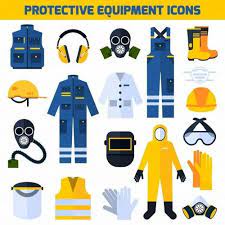Construction sites are bustling hubs of activity, where skilled professionals come together to build the structures we rely on daily. While construction is essential for progress, it's also a high-risk industry. This makes the presence of safety equipment on construction sites not just important but absolutely vital. In this comprehensive article, we will explore the significance of safety equipment in construction, the types of gear used, and how it plays a crucial role in ensuring the well-being of construction workers and the success of projects.
The Importance of Safety Equipment
Construction sites are dynamic environments with numerous hazards, including heavy machinery, heights, electrical work, and more. Accidents can happen, but the right safety equipment can mitigate risks and save lives. Here's why it's indispensable:
1. Injury Prevention
Safety equipment acts as a shield against common construction site injuries. Helmets protect against head injuries, high-visibility vests increase worker visibility, and steel-toed boots safeguard against crushing injuries.
2. Risk Reduction
Many construction tasks involve exposure to dangerous elements. Respirators and eye protection can prevent inhalation of harmful substances or foreign objects striking the eyes. Fall protection equipment, such as harnesses and lanyards, reduces the risk of falls from heights.
3. Legal Requirements
Government regulations mandate the use of safety equipment on construction sites. Failure to comply with these regulations can result in legal consequences, fines, and project shutdowns.
4. Improved Productivity
When workers feel safe and protected, their focus shifts from worrying about their safety to executing tasks efficiently. This, in turn, enhances overall productivity and quality of work.
5. Peace of Mind
Using safety equipment gives construction workers peace of mind, knowing they are well-prepared to handle the challenges of their job. This confidence can boost morale and reduce stress.
Types of Safety Equipment in Construction
A wide range of safety equipment is available for construction sites, each designed to address specific hazards and risks. Let's delve into the most common types:
1. Head Protection
Hard Hats: Hard hats are a fundamental piece of safety gear, protecting the head from falling objects, impact, and electrical hazards. Different classes of hard hats are available, each suited to specific work environments.
2. Eye and Face Protection
Safety Glasses: These protect the eyes from dust, debris, and chemicals. Safety glasses come in various styles, including prescription options for those who need corrective lenses.
Face Shields: Used in conjunction with safety glasses, face shields protect the face and eyes from more extensive hazards, such as high-velocity impact or chemical splashes.
3. Respiratory Protection
Respirators: Construction sites often have dust, fumes, and toxic substances in the air. Respirators filter out these particles, ensuring workers breathe clean, safe air.
4. Hearing Protection
Earplugs and Earmuffs: Construction can be noisy, which can lead to hearing damage over time. Ear protection devices reduce noise levels to prevent hearing loss.
5. Hand and Foot Protection
Gloves: Gloves safeguard the hands against cuts, abrasions, chemicals, and extreme temperatures. Different types of gloves are available, such as leather gloves for general tasks or chemical-resistant gloves for specific applications.
Safety Shoes: Steel-toed boots or safety shoes protect the feet from heavy objects, crushing injuries, and punctures. They also provide stability on uneven terrain.
6. Fall Protection
Harnesses and Lanyards: Workers at heights use fall protection equipment to prevent falls. A harness connects to a lanyard that, in turn, connects to an anchor point, keeping the worker secure.
Guardrails and Safety Nets: These passive fall protection measures create a barrier to prevent falls. Guardrails are typically used on open edges of structures, while safety nets can catch falling workers.
7. High-Visibility Clothing
Vests and Apparel: Workers in high-traffic areas or near heavy equipment wear high-visibility clothing to ensure they are easily seen. This reduces the risk of accidents caused by low visibility.
FAQs on Security Equipment in Construction
1. What are the legal requirements for safety equipment on construction sites?
Legal requirements for safety tackle in construction can vary by location. However, some common requirements include hard hats, eye protection, high-visibility clothing, fall protection gear, and respiratory protection for specific tasks. It's crucial to consult local regulations and industry standards to ensure compliance.
2. How often should safety equipment be inspected and replaced?
Safety equipment should be regularly inspected to ensure it remains in good condition. Damaged or expired gear should be replaced immediately. Inspection frequencies can vary depending on the type of equipment, but it's essential to follow manufacturer recommendations and safety guidelines.
3. Are there specific safety equipment requirements for different construction trades?
Yes, different trades within the construction industry may require specific safety equipment tailored to their unique risks and hazards. For example, welders may need specialized eye protection, and those working with chemicals may require respiratory protection. Tailoring safety equipment to the trade is essential.
4. How can workers ensure their safety equipment is effective?
Workers should be trained on the proper use and care of safety equipment. They must also conduct pre-use inspections and report any issues. Regular maintenance and replacements, as needed, ensure the continued effectiveness of safety gear.
5. Is safety equipment a one-size-fits-all solution?
No, safety equipment should be selected based on the specific hazards and risks present in a construction task or environment. Different types of safety equipment are designed to address various risks, so it's essential to choose the right gear for each situation.
Conclusion
Safety equipment in construction is not a luxury; it's an absolute necessity. It safeguards the well-being of workers, reduces accidents, and ensures compliance with legal requirements. The diverse array of safety equipment available is designed to address the multitude of risks encountered on construction sites. Prioritizing safety equipment not only protects individuals but also enhances the overall efficiency and quality of construction projects. In the world of construction, safety equipment is the linchpin that keeps everything running smoothly and securely.


No comments yet